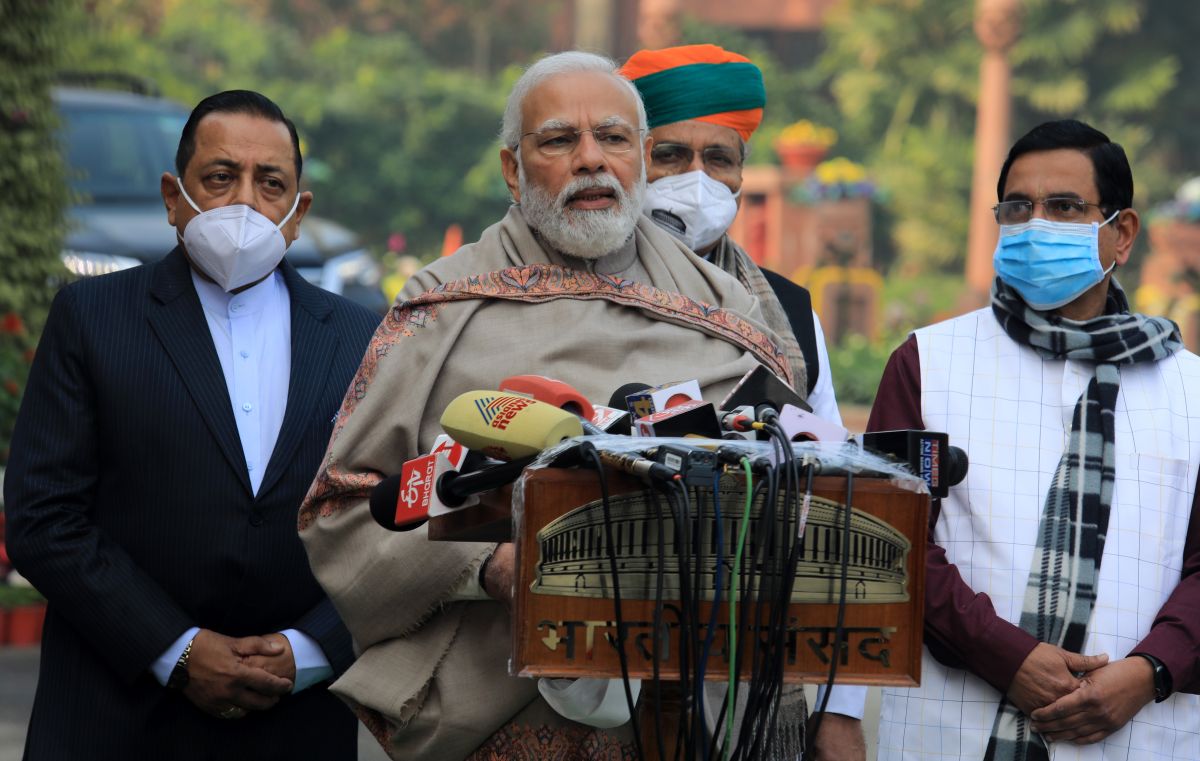India's Ambivalent Stance on Russia's Invasion of Ukraine
India has adopted a neutral stance on Russia’s latest aggression on Ukraine, trying not to alienate any of its main partners, Russia or the U.S. This was well-received in Russia but undermines the foundations of India’s rapprochement with the U.S. and the EU. The top priority for the government of Narendra Modi has been the evacuation of about 20,000 Indian citizens, mostly students, from the war in Ukraine.
 Fot. Naveen Sharma/Zuma Press/Forum
Fot. Naveen Sharma/Zuma Press/Forum
How did India react to the Russian invasion?
India has not openly condemned Russia’s latest aggression against Ukraine and is trying to maintain a neutral stance on the conflict. As a non-permanent member of the UN Security Council in 2020-2022, it abstained from voting on a resolution condemning Russia’s aggression (on 25 February), as well as on a similar resolution at the UN General Assembly (on 2 March). Until the beginning of the war, it was calling for “de-escalation of tensions” and resolution of disputes through “diplomatic dialogue” while stating that any solution must take into account “the legitimate security interests of all countries”, which was recognition of Russia’s arguments. After the invasion, Indian leaders say they were “deeply disturbed by the recent turn of developments in Ukraine” and stressed that “all states” must respect “the sovereignty and territorial integrity of states” without naming Russia or Ukraine. In a phone call with Russian President Vladimir Putin on the day the invasion began (24 February), Prime Minister Modi “appealed for an immediate cessation of violence” and a return “to the path of diplomatic negotiations and dialogue”. In a conversation with President of Ukraine Volodymyr Zelensky on 26 February, Modi reiterated his call to the parties while offering India’s help in “peace efforts”. On 28 February, India announced it would send humanitarian aid to Ukraine (first two tons of medicine and equipment arrived on 1 March).
What are the reasons for India’s ambiguous position?
Russia is India’s traditional and most trusted partner, which, unlike the U.S., has repeatedly supported it on the international forum (including in the case of Kashmir). India is dependent on Russian armaments (around 60-70%), which are crucial in view of its border dispute with China. Russia shares with India advanced military technologies and engages it in the joint production of weapons. Both countries also share the vision of a multipolar international order. India is also concerned that the deterioration of relations with Russia could induce it to tighten further relations with Pakistan and hamper cooperation on Afghanistan.
India views the war as a conflict between the U.S. and Russia, for which the West and NATO’s expansion bear some responsibility. At the same time, in the last 20 years, India has become very close to the U.S. and the EU, which are its most important economic partners and sources of technology. India supports closer cooperation between the democracies in the Indo-Pacific in the face of the threat from authoritarian China. Despite this, many in India, including the ruling BJP party, maintain a high level of distrust towards the West, including in connection with the criticism of the Indian government on democratic backsliding. As a result, the dominant belief is that it is in India’s interest to keep distance from the war, which may also enable it to play the role of mediator in relations between Russia and the U.S.
What are the consequences of the war for India?
Despite its cautious approach to the war, Russia’s attack on Ukraine has already brought various consequences and higher risks to India. One Indian citizen was killed in shelling in Kharkiv and the conflict has forced the government to launch a major evacuation mission of Indian citizens from Ukraine. The decisive reaction from the West will further strengthen the Sino-Russian alliance and will, by weakening Russia, increase its dependence on China. This, in turn, undermines Russia’s credibility as an arms supplier and ally of India in a conflict with China. The sanctions will also hinder future economic cooperation between India and Russia, including arms purchases. The negative impact on the global economy, including energy commodity prices, will hamper India’s recovery from the economic crisis caused by the COVID-19 pandemic and slow the pace of economic growth in 2022 to below the 9% of GDP forecasted by the IMF.
India’s attitude also brings some costs to its global image. Its failure to condemn violations of international law undermines the Modi government’s efforts to present India as a “force for good” and a “leading power” defending international law, a “decider” and not an “abstainer” on international relations. India’s stance puts it closer to the position of authoritarian states than to democratic states.
How will India’s position affect its relationship with the West?
India’s attitude will be a major challenge to cooperation with the U.S. and the EU and lead to a serious crisis of confidence. Still, the U.S. is more ready to accept India’s stance, bearing in mind its security concerns, the common goal of balancing China’s influence in the Indo-Pacific (also within the QUAD coalition), and economic interests. However, U.S. sanctions against India under the CAATSA Act for purchasing the Russian S-400 air defence system is more likely. In relations with the EU, India’s attitude undermines the belief that they are building a “natural partnership” of “like-minded partners” that have “shared values”. This might damage the positive atmosphere and momentum in cooperation built up in recent years. However, it also means a shift towards pragmatic cooperation and a transactional partnership focused on achieving specific shared goals, such as those related to the economy or climate change.
What next?
As the war continues, foreign and domestic pressure will increase on India to condemn the Russian aggression. Nevertheless, India will try to maintain an attitude that does not provoke Russia into retaliation (e.g., suspending the supply of weapons). India is unlikely also to join the Western sanctions and be a part of the international isolation of Russia. Too strong pressure on India could even push it to try to rebuild cooperation in the RIC (Russia, India, China) and BRICS formats (Brazil, South Africa and the RIC states), aimed at reshaping the post-Cold War international order.
In the long run, India will shift closer to the West, with which it has more common interests than Russia. Its trade with the US ($80.5 billion in 2020) and the EU ($80 billion) is much greater than with Russia ($8 billion). It is in the West, not in Russia, that India can look for capital and technology essential to modernise its economy and take over parts of global supply chains. While the EU and the U.S. are tightening their policy towards China, converging with the Indian perspective, Russia is increasingly dependent on China. The U.S. and EU countries may strive to lessen India’s reliance on Russia by offering it attractive alternative for the supply of weapons and cooperation in its production. Only then might it be ready to be more critical of Russia.


